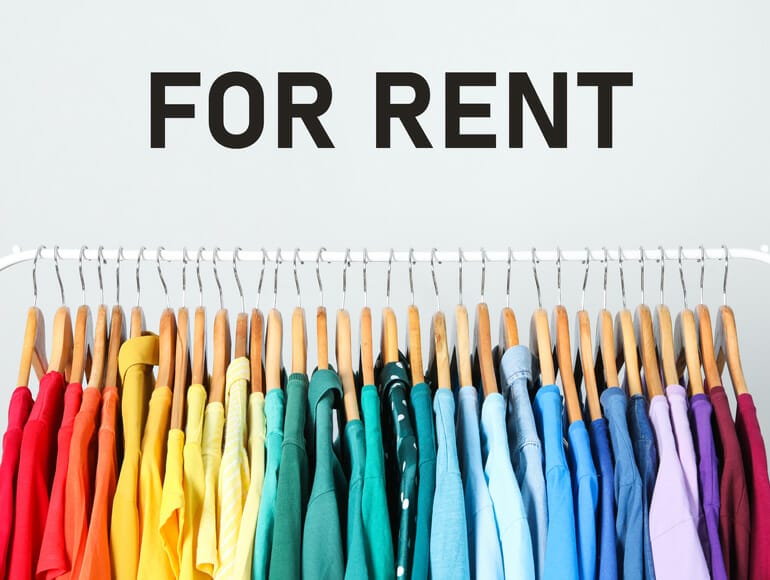It is far too easy to say: “I am sustainable”. Or, even better, to claim: “I am more sustainable than whichever kind of material, product or industrial sector”. The thing is that, while obsessively pursuing green values, whatever solution is bound to slip, sooner or later, on a banana peel. The latest, for example, is the one regarding clothes, bags, and shoes rent fashion
It looks paradoxical.
It is paradoxical.
To some extent though.
In fact, every day the fashion news puts forth new ideas, prompts and green solutions; furthermore, brands, retailers and manufacturers of materials show up to flaunt their sustainable value, which they often compare, in a particularly aggressive way, to their direct competitors’ (in such context leather has been traditionally playing the role of a sacrificial lamb). Likewise, every day someone calls into question, sooner or later, such sustainable mission, therefore triggering the usual escalation of scepticism. This happened and is happening to second-hand business, in which luxury fashion brands have been recently investing in a structural way. It is now rent fashion’s turn to get grilled as well.
Rent fashion
Just to give you a few examples and describe in detail the rent context, we must mention here some of the forerunners in the field of rent: namely, among others, Chinese YCloset and New York Rent to Runway (2009), as well as Le Tote, from San Francisco, and Girl Meets Dress, from London. Then Dress You Can, an Italian remarkable case, running since 2014: in 2019, they won the Premio dei Premi (“The Prize of the Prizes”), issued by the government, for performing as a “champion of innovation for change in Italy” in the Service Design in Services category.
Let us carry on with a few more examples, mostly related to some brands’ experiences: in April 2019, in Paris, at Bon Marché Rive Gauche buyers could rent formal dresses and a tailoring set by Balmain, prices starting from 220 euros. Moreover, once again in France, Louvreuse, a leather goods brand, launched a rent service: customers had the opportunity, just spending 30 euros, to rent, for a couple of days, the brand’s coolest bags (for sale at 370 euros).
Banana peel
All these experiences arise from some specific green purposes. Such purposes are yet wiped out in a survey carried out and published by Environmental Research Letters, a Finnish scientific magazine, whose remarks result in a stunning provocation: “Renting clothes is less environmentally friendly than discarding them”. The survey focused on the assessment of the environmental impact caused by five different ways people may hold and dispose of garments, including renting, reselling, and recycling. It turns out that right renting brings about the highest climate impact. Which undermines, therefore, its green value.
The cost of renting clothes
When it comes to environmental costs, related to renting activity, most of them are presumably due to deliveries, therefore to transportation, along with packaging. For the records, dry cleaning is harmful to environment as well. According to the survey, several rent services abuse of the “circular economy” term, which they consider as a kind of greenwashing.
None of the managers want to revise their own modus operandi – pointed out Dana Thomas, author of “Fashionopolis: The Price of Fast Fashion and the Future of Clothes”, while speaking to The Guardian –. Yet the business, which aims at turning green, would not just need a few changes, but a complete reshaping. Law will eventually work out the issue. No business, in any field, will ever come up as a volunteer to bear a financial loss for the sake of planet Earth. They will do it only when they are forced to abide by the rules.
What action can be possibly taken
According to the survey, improvement in logistics might effectively upgrade renting activity, from an environmental impact point of view, and place it on the same level of reselling. Apparently, the most sustainable model for consumption of fashion goods can be summarized in the following formula: “buy less and wear longer”. “Do you want to be sustainable? Buy less, buy better”, recapped Dana Thomas. According to a research project, conducted by Ellen MacArthur Foundation, in the last 15 years the average number of times people wear their clothes has decreased by 36%. Meanwhile, production has more than doubled.
A marginal note
Just for the records, someone criticized the survey, specifically because of some criteria they used while conducting it. For example, they assume that an item of clothing will be rented 200 times. Furthermore, they suppose customers will cover two kilometres each to collect their article, which, conversely, is often shipped out by post. Nevertheless, they succeeded in opening a debate focusing on sustainability as to those business activities that are deemed as a sustainable and simple alternative option to fast fashion.
Read also:
